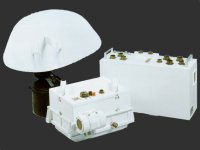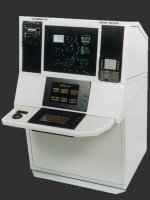Ocean Master
Description of the radar set, tactical-technical characteristics
| Specifications | |
|---|---|
| frequency: | 9.3 - 9.8 GHz
( X–Band) |
| pulse repetition time (PRT): | |
| pulse repetition frequency (PRF): | 300 Hz to 125 kHz |
| pulsewidth (τ): | |
| receive time: | |
| dead time: | |
| peak power: | 6 kW or 8 kW |
| average power: | 100 W or 400 W |
| instrumented range: | 7.5 to 240 NM |
| range resolution: | 3 m |
| accuracy: | |
| beamwidth: | |
| hits per scan: | |
| antenna rotation: | 6-30 rpm |
| MTBCF: | |
| MTTR: | |
Ocean Master
The Ocean Master radar family is a new generation of maritime radar designed to meet a wide range of mission requirements. It consists of two versions, Ocean Master 100 and Ocean Master 400, both of which are suitable for fixed- or rotary-wing aircraft. Mission capabilities include anti-surface vessel warfare, anti-submarine warfare, exclusive economic zone surveillance, and search and rescue. It opreates in I-Band and provides advanced capabilities for detection, tactical processing, situation display, navigation and weather avoidance.
Ocean Master systems are frequency-agile, compact, lightweight radars; the entire assembly, including the stabilised antenna weighing less than 80 kg. Two different transmitters with different power levels are offered, and several types of antenna.
It is designed to detect all types of targets, including periscopes, small boats and lifeboats. This capability relies on the use of a high pulse compression rate, programmable radar signal and data processing with pulse-to-pulse and scan-to-scan integrations, and a wide range of antenna rotation periods. Tactical processing provides the operator with a comprehensive situation picture with multiple target track-while-scan, radar map memory, target classification and over-the-horizon targeting capability. The interface with the navigation and combat system of the aircraft uses standard busses, and the radar can handle calculations for smaller systems not equipped with a mission computer. Target classification makes use of both profile and ISAR techniques whereby restitutions of the ship silhouettes are made on the basis of the echoes reflected by the different structures on the ship.
The System is extremely reliable and performs comprehensive built-in test functions and features. Flexible interface capabilities enable simple system integration. Units and sub-units are easily exchangeable without adjustment or calibration.

Figure 3: The Ocean Masters block diagram
Design.
The Ocean Master in the basic version
comprises only 3 units:
- antenna unit
- transmitter unit
- exciter/receiver/processor unit
Man machine interface includes:
- display
- controls
Specifications.
Antenna
Type: offset reflector with RF amplifier
Size: several available
Dimensions: 660 x 350 mm; 955 x 350 mm
Weight: 15 and 16 kg
Stabilisation: 2 axis in line of sight; ±20% roll; ±10% pitch
Tilt: selectable from +4 to -29°
Rotation rate: 6-30 rpm automatically selected within the mode
Scan width:360° or sectoral 60-210°
Transmitter
Type: TWT
coherent transmitter, wideband frequency agility
Frequency: I-Band
Average power: 100 W (Ocean Master 100); 400 W (Ocean Master 400)
Peak power: 6 kW (Ocean Master 100); 8 kW (Ocean Master 400)
Weight: 29 kg


